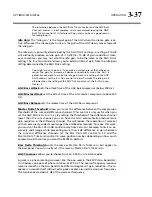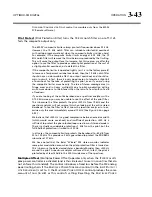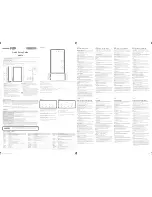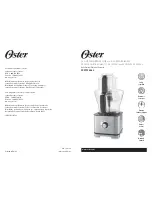
OPTIMOD-FM DIGITAL
OPERATION
3-29
boost at 100Hz in combination with a Bass Shelf boost at 6 dB/octave.
The equalizer, like the classic Orban analog parametrics such as the 622B, has con-
stant “Q” curves. This means that the cut curves are narrower than the boost curves.
The width (in octaves) is calibrated with reference to 10 dB boost. As you decrease
the amount of EQ gain (or start to cut), the width in octaves will decrease. However,
the “Q” will stay constant.
“Q” is a mathematical parameter that relates to how fast ringing damps out. (Tech-
nically, we are referring to the “Q” of the poles of the equalizer transfer function,
which does not change as you adjust the amount of boost or cut.)
The curves in the 8500S’s equalizer were created by a so-called “minimax” (“mini-
mize the maximum error,” or “equal-ripple”) IIR digital approximation to the curves
provided by the Orban 622B analog parametric equalizer. Therefore, unlike less so-
phisticated digital equalizers that use the “bilinear transformation” to generate EQ
curves, the shapes of the 8500S’s curves are not distorted at high frequencies.
Midrange Parametric Equalizer
is a parametric equalizer whose boost and cut
curves closely emulate those of an analog parametric equalizer with conventional
bell-shaped curves.
MID FREQ
determines the center frequency of the equalization, in Hertz.
Range is 250-6000Hz.
MID GAIN
determines the amount of peak boost or cut (in dB) over a
±
10 dB range.
MID WIDTH
determines the bandwidth of the equalization, in octaves.
The range is 0.8-4.0 octaves. If you are unfamiliar with using a parametric
equalizer, 1 octave is a good starting point.
The audible effect of the midrange equalizer is closely associated with the amount
of gain reduction in the midrange bands. With small amounts of gain reduction, it
boosts power in the presence region. This can increase the loudness of such material
substantially. As you increase the gain reduction in the midrange bands (by turning
the
M
ULTIBAND
D
RIVE
(Multiband Drive) control up), the
M
ID
G
AIN
control will have pro-
gressively less audible effect. The compressor for the midrange bands will tend to
reduce the effect of the Mid frequency boost (in an attempt to keep the gain con-
stant) to prevent excessive stridency in program material that already has a great
deal of presence power. Therefore, with large amounts of gain reduction, the den-
sity of presence region energy will be increased more than will the level of energy in
that region. Because the 3.7 kHz band compressor is partially coupled to the gain
reduction in the 6.2 kHz band in most presets, tuning
M
ID
F
REQ
to 2-4 kHz and turn-
ing up the
M
ID
G
AIN
control will decrease energy in the 6.2 kHz band — you will be
increasing the gain reduction in both the 3.7 kHz and 6.2 kHz bands. You may wish
to compensate for this effect by turning up the
B
RILLIANCE
control.
Use the mid frequency equalizer with caution. Excessive presence boost tends to be
audibly strident and fatiguing. Moreover, the sound quality, although loud, can be
very irritating. We suggest a maximum of 3 dB boost, although 10 dB is achievable.
Содержание OPTIMOD-FM 8500S
Страница 1: ...Operating Manual OPTIMOD FM 8500S Digital Audio Processor Version 1 0 Software...
Страница 7: ...Operating Manual OPTIMOD FM 8500S Digital Audio Processor Version 1 0 Software...
Страница 26: ......
Страница 56: ......
Страница 164: ......
Страница 308: ......
Страница 310: ...6 28 TECHNICAL DATA ORBAN MODEL 8500S CONTROL BOARD PARTS LOCATOR...
Страница 316: ...6 34 TECHNICAL DATA ORBAN MODEL 8500S 5700 8600S I O DSP BOARD PARTS LOCATOR DRAWING 32370 860 01...
Страница 321: ...OPTIMOD FM DIGITAL TECHNICAL DATA 6 39 8600S I O BOARD COMPOSITE SCA DAUGHTERBOARD SHEET 4b of 12 62310 000 02 1...
Страница 330: ...6 48 TECHNICAL DATA ORBAN MODEL 8500S FRONT REAR FRONT PANEL PARTS LOCATOR DIAGRAM 32275 000 09...
Страница 334: ...6 52 TECHNICAL DATA ORBAN MODEL 8500S...
Страница 335: ...OPTIMOD FM DIGITAL TECHNICAL DATA 6 53...
















































